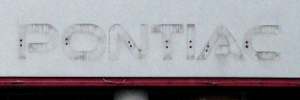|
By accessing or using The Crittenden Automotive Library™/CarsAndRacingStuff.com, you signify your agreement with the Terms of Use on our Legal Information page. Our Privacy Policy is also available there. |

Oakland
|
|---|
|
|
Oakland
Vehicle Marque
An automobile company founded in 1907 and division of
General Motors from 1909-1931. Considered the precursor to
Pontiac, which was created to be a "companion make" to Oakland.
At the end of the companion make program the Oakland brand was cut instead of the better-selling Pontiac, making
Pontiac the only companion make to outlast its parent.
Vehicle names used by Oakland throughout history include:
Sensible Six and
Six.
History
The following section is an excerpt from Wikipedia's Oakland Motor Car Company page on 2 June 2021, text available via the Creative Commons Attribution-ShareAlike 3.0 Unported License.
The Oakland Motor Car Company of Pontiac, Michigan, was an American automobile manufacturer and division of General Motors. Purchased by General Motors in 1909, the company continued to produce modestly priced automobiles until 1931 when the brand was dropped in favor of the division's Pontiac make.
The company was created by Edward Murphy who owned the Pontiac Buggy Company and Alanson Brush who was working as a consultant in Detroit after leaving the Cadillac Motor Company. Oakland Motor Company was named for Oakland County, Michigan, in which it was based. As originally conceived and introduced, the first Oakland used a design created by Brush and presented to Murphy who liked the idea and decided to go into business. The vertical two-cylinder engine that rotated counterclockwise was originally presented to Cadillac but was rejected. This design by Alanson Partridge Brush, inventor of the single-cylinder Cadillac and Brush Runabout, also featured a planetary transmission. The 1908 Oakland came in five body styles, designated Model A–E , varing from a runabout to a landaulet. The first year of Oakland production, 1908, had 278 vehicles roll off the line.
After one year of production, Oakland's principal founder, Edward Murphy, sold half of the company to William C. Durant's General Motors Corporation in early 1909. When Murphy died in the summer of 1909, GM acquired the remaining rights to Oakland. Within General Motors, Oakland was later slotted as their entry-level brand below the more expensive Oldsmobile, Buick, and Cadillac cars. Conventional four-cylinder engined models were introduced shortly after the GM takeover, and GM didn't acquire the volume-priced Chevrolet until 1917, and Oakland found itself competing with the Ford Model T introduced in October 1908. Once GM assumed operations of Oakland, production was moved to the factory that manufactured Cartercar in Pontiac, Michigan, another Durant acquisition that was cancelled while the resources were newly utilized, and the Oakland Model 40 was introduced. Starting with 1910 Oakland was exclusively offering 4-cylinder flathead engines with five different wheelbases and their advertising slogan was "The Car with a Conscience". By early 1920, however, production and quality control problems began to plague the division. In 1921, under new General Manager Fred Hannum, a consistent production schedule was underway and the quality of the cars improved, and Oakland vehicles shared the GM A platform used by Chevrolet. One marketing tactic was the employment of a quick-drying bright blue automotive lacquer by Duco (a DuPont brand product), leading to the slogan "True Blue Oakland Six". The Oakland was built only in Pontiac, Michigan, which is the county seat of Oakland County. The name antedates any GM association with an automobile manufacturing facility in Oakland, California, that built Chevrolet vehicles before Chevrolet joined GM called Oakland Assembly.
As General Motors entered the 1920s, the product ladder started with the price-leading Chevrolet marque, and then progressed upward in price, power, and luxury to Oakland, Oldsmobile, Buick, and ultimately Cadillac. By the mid-1920s, a sizable price gap existed between Chevrolet and Oakland, as well as a wide gap between Oldsmobile and Buick. Also, a product gap existed between Buick and Cadillac. General Motors pioneered the idea that consumers would aspire to buy up an automotive product ladder if a company met certain price points-called the Companion Make Program. To address this, General Motors authorized the introduction of four brands priced and designed to fill the gaps. Cadillac would introduce the LaSalle to fill the gap between Cadillac and Buick. Buick would introduce the Marquette to handle the upper end of the gap between Buick and Oldsmobile. Oldsmobile would introduce the Viking, which took care of the lower end of the same gap.
Oakland's part in this plan was the 1926 Pontiac, a shorter-wheelbase "light six" priced to sell at a four-cylinder car's price point, but still above Chevrolet. Pontiac was the second of the companion marques introduced, following LaSalle, and in its first year sold 49,875 units. By 1929, GM sold 163,000 more Pontiacs than Oaklands. The discontinuation of Oakland was announced with the onset of the Great Depression in 1931. Pontiac was the only companion make to survive beyond 1940, or to survive its "parent" make.
Article Index


















